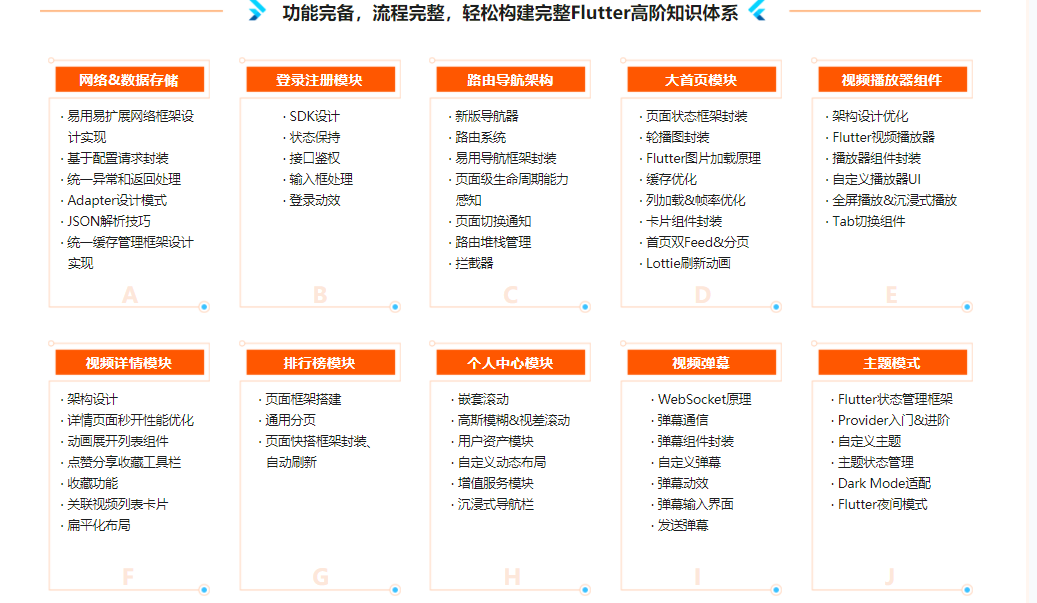在前两篇文章中,我们已经了解了Flutter的基础知识,包括Flutter的设计理念、框架结构、Widget系统、基础Widgets以及布局。在本文中,我们将进一步探讨Flutter的高级主题,包括处理用户交互、创建动画、访问网络数据等等。为了更好地理解这些概念,我们将通过实际的示例代码来详细讲解。

一、处理用户交互
在移动应用中,用户交互是非常重要的一部分。Flutter提供了丰富的Widgets来处理用户的触摸、点击和手势等交互事件。
1. 手势识别
Flutter提供了GestureDetector Widget来识别各种手势,例如点击、长按、双击等。下面是一个简单的示例,演示如何在点击按钮时改变文本内容:
import 'package:flutter/material.dart';void main() {runApp(MyApp());
}class MyApp extends StatelessWidget {@overrideWidget build(BuildContext context) {return MaterialApp(home: TapExample(),);}
}class TapExample extends StatefulWidget {@override_TapExampleState createState() => _TapExampleState();
}class _TapExampleState extends State<TapExample> {String _text = 'Click the button';void _handleTap() {setState(() {_text = 'Button Clicked';});}@overrideWidget build(BuildContext context) {return GestureDetector(onTap: _handleTap,child: Container(padding: EdgeInsets.all(12),color: Colors.blue,child: Text(_text,style: TextStyle(color: Colors.white,fontSize: 18,),),),);}
}在上述代码中,我们使用GestureDetector包装了一个Container,当用户点击Container时,_handleTap函数会被调用,文本内容会改变为’Button Clicked’。
2. 拖动手势
Flutter也支持拖动手势,你可以使用Draggable和DragTarget来实现拖放操作。下面是一个简单的示例,演示如何将一个小方块从一个容器拖动到另一个容器:
import 'package:flutter/material.dart';void main() {runApp(MyApp());
}class MyApp extends StatelessWidget {@overrideWidget build(BuildContext context) {return MaterialApp(home: DragExample(),);}
}class DragExample extends StatefulWidget {@override_DragExampleState createState() => _DragExampleState();
}class _DragExampleState extends State<DragExample> {bool _dragging = false;Offset _position = Offset(0, 0);void _handleDrag(DragUpdateDetails details) {setState(() {_position = _position + details.delta;});}void _handleDragStart() {setState(() {_dragging = true;});}void _handleDragEnd() {setState(() {_dragging = false;});}@overrideWidget build(BuildContext context) {return Stack(children: [Positioned(left: _position.dx,top: _position.dy,child: Draggable(onDragStarted: _handleDragStart,onDragEnd: (_) => _handleDragEnd(), // 修改为不带参数的形式onDragUpdate: _handleDrag,child: Container(width: 100,height: 100,color: Colors.blue,),feedback: Container(width: 100,height: 100,color: Colors.blue.withOpacity(0.5),),childWhenDragging: Container(),),),Center(child: DragTarget(onAccept: (value) {setState(() {_position = Offset(0, 0);});},builder: (context, candidates, rejected) {return Container(width: 200,height: 200,color: Colors.grey,);},),),],);}
}在上述代码中,我们使用Draggable将一个蓝色的小方块包装起来,并将其拖动到DragTarget中,当拖动结束时,小方块会返回DragTarget的中心。
二、创建动画
Flutter提供了强大的动画支持,你可以使用AnimationController和Tween来创建各种动画效果。下面是一个简单的示例,演示如何使用AnimationController和Tween来实现一个颜色渐变动画:
import 'package:flutter/material.dart';void main() {runApp(MyApp());
}class MyApp extends StatelessWidget {@overrideWidget build(BuildContext context) {return MaterialApp(home: ColorTweenExample(),);}
}class ColorTweenExample extends StatefulWidget {@override_ColorTweenExampleState createState() => _ColorTweenExampleState();
}class _ColorTweenExampleState extends State<ColorTweenExample>with SingleTickerProviderStateMixin {late AnimationController _controller;late Animation<Color?> _animation;@overridevoid initState() {super.initState();_controller = AnimationController(vsync: this,duration: Duration(seconds: 2),);_animation = ColorTween(begin: Colors.blue, end: Colors.red).animate(CurvedAnimation(parent: _controller, curve: Curves.easeInOut));_controller.repeat(reverse: true);}@overridevoid dispose() {_controller.dispose();super.dispose();}@overrideWidget build(BuildContext context) {return Scaffold(appBar: AppBar(title: Text('ColorTween Example'),),body: Center(child: AnimatedBuilder(animation: _animation,builder: (context, child) {return Container(width: 200,height: 200,color: _animation.value,);},),),);}
}在上述代码中,我们使用AnimationController和ColorTween来创建一个颜色渐变动画,将蓝色的容器逐渐变为红色。
三、访问网络数据
在现代应用中,访问网络数据是很常见的需求。Flutter提供了http包来处理网络请求。下面是一个简单的示例,演示如何使用http包来获取JSON数据并显示在ListView中:
import 'dart:convert';
import 'package:flutter/material.dart';
import 'package:http/http.dart' as http;void main() {runApp(MyApp());
}class MyApp extends StatelessWidget {@overrideWidget build(BuildContext context) {return MaterialApp(home: HttpExample(),);}
}class HttpExample extends StatefulWidget {@override_HttpExampleState createState() => _HttpExampleState();
}class _HttpExampleState extends State<HttpExample> {List<dynamic> _data = [];@overridevoid initState() {super.initState();_getData();}Future<void> _getData() async {final response =await http.get(Uri.parse('https://jsonplaceholder.typicode.com/posts'));if (response.statusCode == 200) {setState(() {_data = json.decode(response.body);});}}@overrideWidget build(BuildContext context) {return Scaffold(appBar: AppBar(title: Text('HTTP Example'),),body: ListView.builder(itemCount: _data.length,itemBuilder: (context, index) {return ListTile(title: Text(_data[index]['title']),subtitle: Text(_data[index]['body']),);},),);}
}在上述代码中,我们使用http包来获取JSON数据,并将数据解析后显示在ListView中。
结束语

通过本文的学习,你已经了解了Flutter的高级主题,包括处理用户交互、创建动画以及访问网络数据等。这些知识将帮助你更深入地掌握Flutter的开发能力,为你的应用添加更多功能和交互体验。希望本文对你的Flutter学习之旅有所帮助,祝你在Flutter的世界中取得更多成功!



--简介)


)


)









:计算属性)